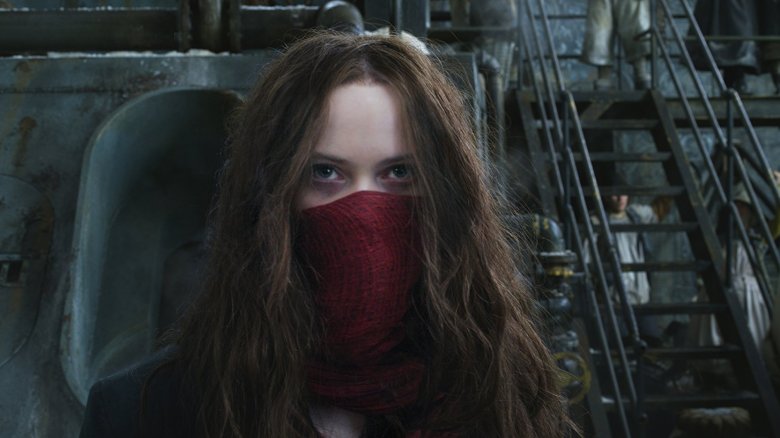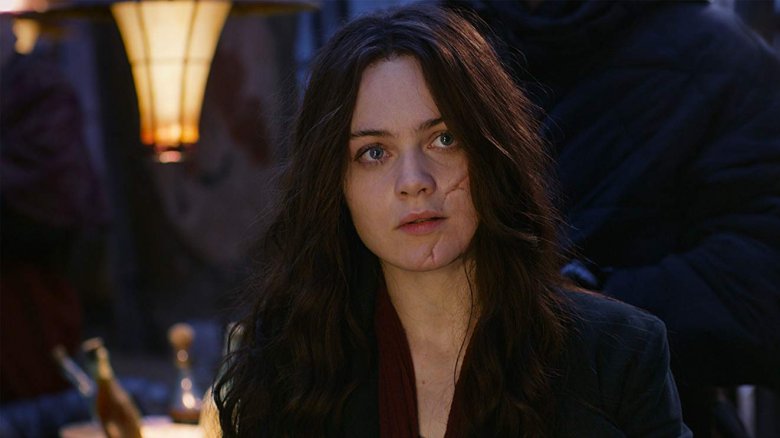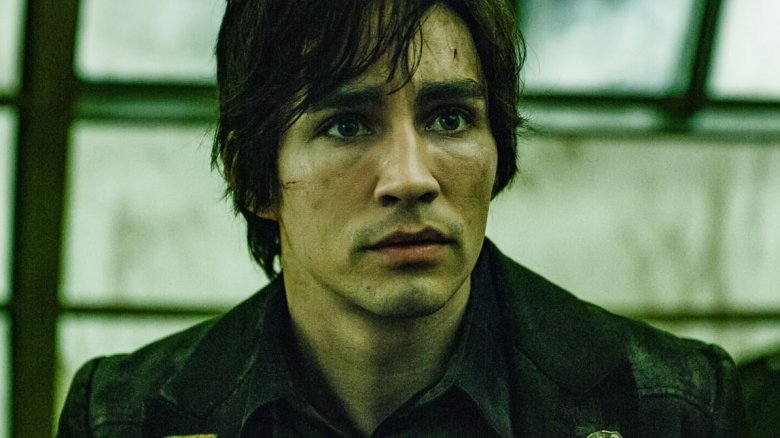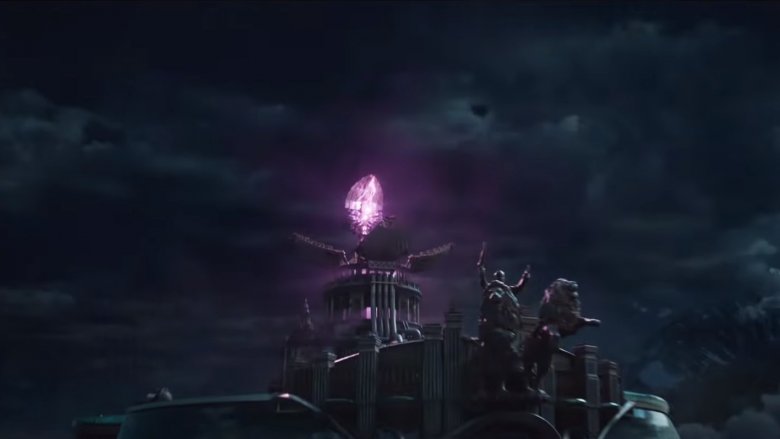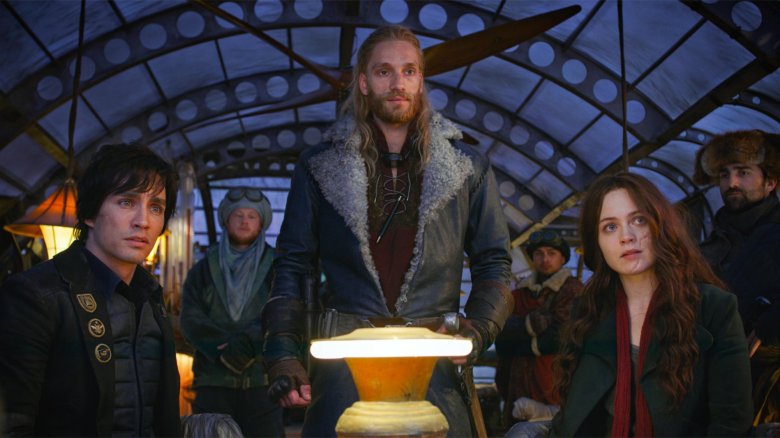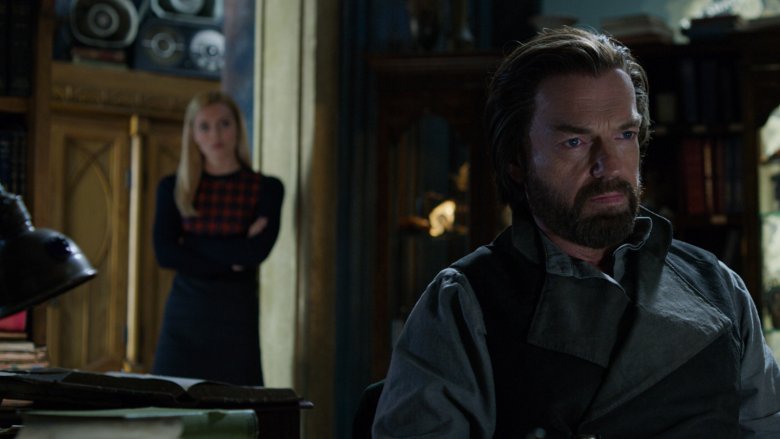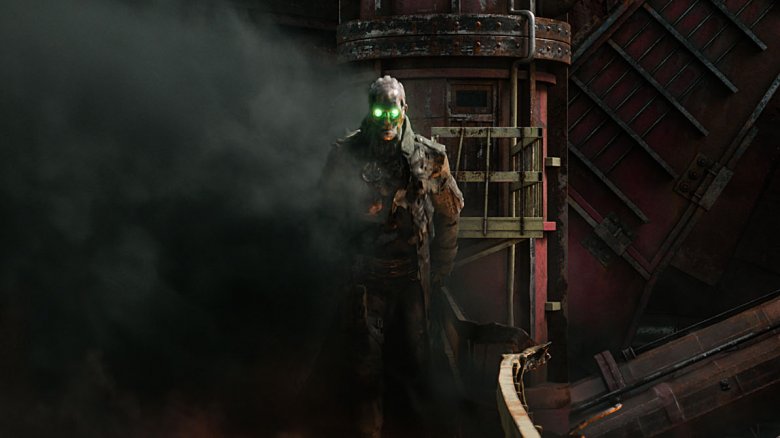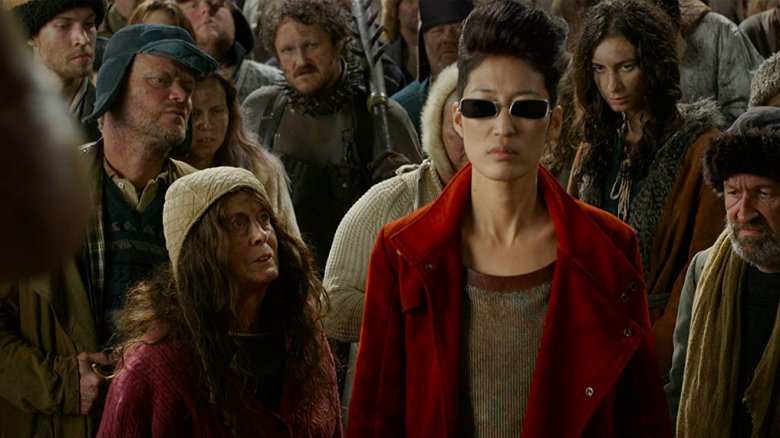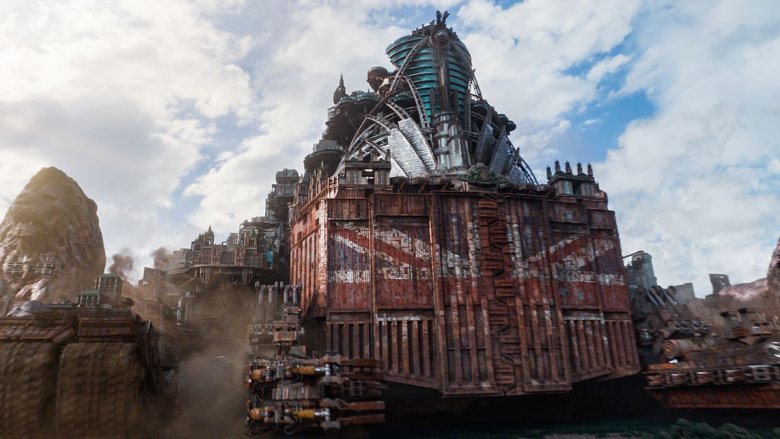The Ending Of Mortal Engines Explained
At long last Mortal Engines has made its way to theaters. Nearly two decades after Philip Reeve's beloved series of novels began, producer and co-screenwriter Peter Jackson's long journey to get the world of traction cities onscreen is finally a reality. The film is truly epic in scope, full of massive world-building and rich in detail, and that means there's a lot to digest and contemplate by the time the credits roll. The film is a potential franchise launcher, full of characters and ideas that are only partially explored in its runtime, which leaves us with plenty of questions and possibilities to ponder. Even though the ending of the central conflict of Mortal Engines feels pretty definitive, there are so many loose ends to consider that the film and its universe will stay in your head long after you've left the theater. Here's our breakdown of the ending of Mortal Engines, and what it means for the future of the world and its characters. SPOILERS AHEAD!
Hester's future
The driving force of Mortal Engines is Hester Shaw (Hera Hilmar), a young woman who's devoted most of her life, when she wasn't eager to run from it, to the fulfillment of a single goal: Vengeance for the death of her mother. Her target is Thaddeus Valentine (Hugo Weaving), the supposed mastermind of London and its future as a traction city in a world in which humanity is increasingly resisting such things. In pursuing her vengeance, Hester unearths a plot to bring superweapons back into the world, and as a result plays a key role in bringing down Valentine and his plan to dominate the future of the Earth through the Medusa weapon. When the dust settles, Hester is finally free of the burdens of her past, ready to travel the world with Tom (Robert Sheehan) in the airship they've inherited. Other than flying around the globe, though, what will Hester actually do? The film leaves that open-ended, but it's quite possible that she will embrace the shared legacy of both her mother and her caretaker, Shrike (Stephen Lang), and begin a life as a collector and archaeologist, finding and fixing broken things in an effort to learn more about the world.
Tom the aviator
Like Hester, Tom also finds what he most desires at the end of the world. An aspiring aviator who settled for life as a historian, Tom spends much of the film thrust into an adventure he never asked for, and by the end he seems to have everything he ever wanted. He has a woman he loves by his side, an airship to take care of, and the world at his fingertips, so he invites Hester to travel with him, and she agrees. Of course, we can't expect these two to be nothing but aimless wanderers, particularly with Tom's natural curiosity and sense of history, so what will they do? If Hester is a collector and a seeker, then Tom might end up both joining her and working toward his own ends in an effort to — as he did back in London — find and secure dangerous Ancient tech. If one maniacal world leader was able to get his hands on enough firepower to recreate Medusa, then another might as well, and Tom has seen the danger of that firsthand. We could see him take it upon himself to make sure that never happens.
The threat of Medusa
We are told in Mortal Engines' prologue, and reminded throughout the film, that the world as we know it was wiped out in just 60 minutes by a war using quantum energy weapons. By the end of the film we see one such weapon, Medusa, in action, and Thaddeus Valentine is nearly able to put his plan of world domination into action because of it. Valentine achieves this by hoarding old tech until he has enough to recreate the weapon, with the control system he stole from Pandora Shaw at the center of it all. Now that the fight over Medusa is done, word of what happened will spread, and sadly some may learn the wrong lessons. We know that there are still other powerful traction cities out there who will now learn of both the fall of London and of Valentine's plan. Is there a leader among them who will think he or she can do a better job with the same idea? If so, the Anti-Traction League will have to be ever vigilant.
A vulnerable population
Valentine and his plans for conquest are both thwarted by the end of Mortal Engines, and they're thwarted pretty thoroughly. Medusa is destroyed, London's engines are crippled, and Valentine himself is crushed by his own city. As definitive as that particular victory is for the Anti-Traction League, though, the forces of peace have still suffered heavy losses. The Shield Wall protecting the League was dealt heavy damage, and the League's entire fleet of airships was destroyed by Medusa. Even as the people of London are integrated into the League and the rebuilding begins, that still leaves everyone involved in a very vulnerable position. We know that numerous traction cities have tried and failed to breach the Shield Wall in the past, but now the wall has taken a lot of damage. Will one of the major cities still out there in the Great Hunting Ground decide now is the proper time to strike? It's something the League has to be prepared for.
The legacy of Thaddeus Valentine
Thaddeus Valentine may be dead, and his awful plan may be thwarted, but the world may not hear the full story of what really happened. At least, not right away. The film spends a lot of time showing us that Valentine was a respected, even beloved, figure among people who still supported traction cities. He was the author of several books, a seemingly benevolent leader, and a supposed voice of the future — he was supposed to be a savior, and instead he was a secret tyrant. Now, he's left a damaged world behind, and someone has to tell the true story. That task may fall to his daughter Katherine (Leila George), who with the Lord Mayor and her father both dead seems to have assumed at least a temporary leadership among Londoners. As her city looks to her for answers and Tom and Hester strike out on their own, Katherine may be the real voice reason in a world that wants answers.
The last of the Lazarus Brigade?
Mortal Engines makes it very clear that Shrike, a reanimated supersoldier with only vague memories of the human life he once had, is supposed to be the last of his kind. It's mentioned more than once, and Shrike's death is treated with a lot of weight in the film, letting us know that a monstrous age is passing when he's able to finally retreat into his good memories and fade away into nothing. What Hester knows that other people seem to not know, however, is that Shrike had a plan to make her like him. He wanted to merge her with circuitry, kill her and then bring her back with no memories of her past pain. He wanted to do this as a benevolent gesture, and even built the framework to make it happen, but died before he could do it. This of course begs the question: Did others like Shrike ever attempt to do the same thing? Are there other Stalkers living as he did, in hidden pockets of the world, trying to make more of themselves?
The legacy of Windflower
Throughout the film, through Hester and Tom's eyes, we learn a little of the story and the struggles of Anna Fang (Jihae), the Anti-Traction leader and former slave who both saves our heroes multiple times and becomes an important symbol of resistance throughout. Anna, also known as "Windflower," gives her life to save the League, dueling to the death with Valentine to give Hester enough time to shut down Medusa. Now, with Anna gone, the world will learn her stories through the eyes of those she helped. The League itself will continue to tell stories of her heroism, but what about the greater implications of her work? The slave trade is still alive and well in this version of the world, and we know that Anna was both a victim of it and a fighter against it. As they venture out to have their own adventures, will Hester and Tom do what Anna did and hit the slave markets where it hurts?
The future of London
London seems to have ended its run as a traction city by the time the credits roll on Mortal Engines. The city is still mostly intact, but St. Paul's Cathedral isn't, its defenses have been destroyed, and its engine have been severely damaged. It would take considerable time and resources to get the city back in fighting shape and mobile again, and its citizens don't seem very interested in trying. The last time we see the people of London, they're being welcomed into the Anti-Traction League with Katherine Valentine leading them into what would seem to be a new age of peace. So what happens to London as an institution? Hopefully the remaining keepers of the city's culture will preserve what they can and integrate it into a new settlement within the League, which actually presents a very interesting storytelling opportunity. In attempting to ram London through the Shield Wall, Valentine was essentially repeating the acts of colonialism that his ancestors carried out by expanding the British Empire throughout the world. Now the British people are being taken in by Asia, where they will be asked to embrace a new way of life as guests, not as conquerors.
The future of travel
Thaddeus Valentine's mission to take over the lands of the Anti-Traction League is a twisted, tyrannical quest, but it stems from a legitimate idea: The system of "Municipal Darwinism" in which cities continue to fight for supremacy simply cannot continue to sustain itself. Eventually the world will reach a breaking point, and with the continued existence of traction cities, that breaking point just keeps approaching even faster. So what's a civilization to do when the Anti-Traction League gains a major victory but there's still a need to travel and spread the word? Well, airships seem like a decent option, even though the city of Airhaven is destroyed midway through the movie. Tom always wanted to be an aviator, and he now has the means to travel the world with Hester at his side. Together they have a story to tell, and they can help the world move on from the mistakes of its past. It's a long road, but air supremacy could be the next great frontier of the Mortal Engines universe.
